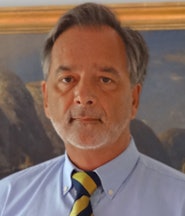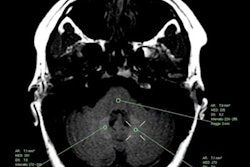
Researchers have observed increased signal intensity in plain T1-weighted MR images in a number of brain structures of patients who had undergone several contrast-enhanced studies. They believe these hyperintensities are induced by tiny amounts of gadolinium (Gd) held back in the brain.
At present, investigations are underway to try to understand how and why Gd is retained in the brain and other tissues in the body. Studies focus on the contrast agents' in vivo stability (combination of equilibrium, kinetic, and pharmacokinetic properties), how Gd-containing compounds cross biological barriers, the chemical form of the retained compounds (intact contrast agents, or soluble and insoluble Gd-containing compounds), and the relationship between Gd compounds and local image hyperintensities.
These studies open new avenues beyond the potential toxicity of the used Gd-complexes since they make possible advanced insights into thermodynamics and kinetics of metal-containing preparations in living systems.1
Some researchers continue to study possibly still unknown physiological-biochemical pathways allowing gadolinium to pass the blood-brain barrier (BBB), but evidence supporting such ideas remains scarce.
A personal view
There's a long history here. The likely lack of stability of linear Gd compounds was hotly debated at the first conference on MR contrast agents organized by the Round Table Foundation (TRTF) and the European Magnetic Resonance Forum (EMRF) in 1988,2,3 long before the first occurrence of nephrogenic systemic fibrosis (NSF).
 Dr. Peter Rinck, PhD, is a professor of radiology and magnetic resonance. He is the president of the Council of the Round Table Foundation and the chairman of the board of the Pro Academia Prize.
Dr. Peter Rinck, PhD, is a professor of radiology and magnetic resonance. He is the president of the Council of the Round Table Foundation and the chairman of the board of the Pro Academia Prize.My personal explanation of the uptake of Gd dates back to research done by our group in the 1980s, even before Gd agents entered the market.4 In a patient population of some 450 with definite, probable, and possible multiple sclerosis (MS) referred to us for MRI, some 40 with definite MS were chosen randomly for relaxation time measurements of plaque-free gray and white matter. Overall white-matter T2 was slightly higher in MS patients than in a non-MS population. These changes do not influence image contrast and are not visible on MRI.
However, it is known that in many different brain diseases, localized or general breakdown of the BBB can be observed -- among them MS, Alzheimer's disease, epilepsy, amyotrophic lateral sclerosis, and edema, but also stroke and brain injuries as well as systemic diseases, such as liver failure. Work with animal models of disease and with cell culture BBB models has enabled the identification of some of the molecular mechanisms that cause changes to the BBB.5
Thus, diminutive amounts of gadolinium may enter the brain in such patients and, after multiple applications of a Gd-based contrast agent, slowly accumulate and visibly change MR image contrast.
In the discussion of this topic at the TRTF/EMRF meeting on MR contrast agents, held in Mons, Belgium, in May 2019, there was also criticism that patents on contrast agents and accessories and the enforcement of poor quality patents by "patent trolls" (e.g., on contrast-enhanced MR angiography) have had a negative impact on the development of better and safer agents.
Signal and contrast enhancement
Another area of interest at the conference was the intrinsic insensitivity of MRI and possibly boosting procedures with unspecific or targeted molecules or techniques. Overviews and new ideas covered the whole spectrum of prospects, from optimizing the relaxivity of existing or possible compounds to the use of chemical exchange saturation transfer (CEST) agents or hyperpolarized (HP) molecules providing the possibility of investigating in vivo metabolic processes.
Hyperpolarization requires specific and expensive additional equipment, which makes it ill-suited for routine clinical tasks. Hyperpolarized gases can be used for lung imaging, but the application of perfluorinated gases might be more practicable. As with CEST, additional hardware and software have to be installed.
New classes of contrast agents with relaxivities several hundred percent higher than today's agents in clinical use below 2 tesla have been proposed; however, the safety and stability of these complexes have not yet been examined in animals and humans. They might be necessary for ultrahigh-field research applications, mostly for animal experiments, where bigger contrast agent molecules will provide better relaxivity.
Focus on targeting
Targeted theragnostic compounds were proposed in an unpublished description by Paul Lauterbur, PhD, as early as 1977. However, only a few have reached the clinical level, one being the novel project in France involving nanoparticles made of polysiloxane and gadolinium chelates. In a clinical phase IB trial, it was shown that after intravenous administration, they accumulate in tumors and act as a radiosensitizer to increase locally the effect of radiotherapy, for instance for the treatment of multiple brain metastases by whole-brain irradiation. Their biodistribution and the accumulation in the tumor can be followed by MRI due to the presence of Gd.
It remains to be seen which of the hundreds of different projects will leave the labs of the research institutes and will be turned into routine patient applications. At present, we are using MR contrast agents introduced 25 to 30 years ago.
Quo vadis?
For more than 30 years, scientific leaders and young researchers in the development of MRI contrast agents have met at biennial conferences arranged by the EMRF and TRTF.
From the beginning, attendees comprised both university scientists and representatives from industry. Earlier, these meetings were very attractive for researchers working for the contrast agent manufacturers to present their basic research in a setting that fosters discussion, collaboration, and advancement in the field without being pressured by their sales and marketing departments. However, in the meantime, commercial basic and applied research has been drastically cut back, some of the major companies have changed hands, and vendors focus mainly on the marketing of generic compounds, some selling products developed by their competitors after the original agent's patent expiration.
The leitmotif of this year's two-day meeting was "Standing at the Crossroads: 40 Years of MR Contrast Agents" -- what has happened in the field during the last 40 years after the first description of MR contrast agents by Lauterbur in 1978?6 What have we learned, what is the state of the art, and where will we go to?
The meeting was organized with alternating review lectures of the developments, improvements, challenges, and failures of the last 30 years given by leading experts in the field and presentations of novel theoretical tools, new ideas, and new compounds by young scientists.
The opening lecture was titled "MR imaging -- Quo vadis?" It gave an account of the factors influencing the development of the technique, scientifically, commercially, and socially. The talk was not about the development of techniques and great leaps forward in MR imaging coming up soon, but rather it described repercussions and forces from the outside -- realities which during the last 40 years formed MR imaging and will influence and guide the development in the future. This included its instrumentation and accessories, academic and industrial research, fashions and hypes, global cultural differences, changes within societies and human factors, disruptive technologies, the worldwide market for MR instrumentation and contrast agents, and new paradigms. AuntMinnieEurope.com has published excerpts.7
Among the experts, there was agreement that the domain of medical imaging will be mostly at 1.5 tesla in Europe, North America, and Japan, and 0.3 to 1.5 tesla for instance in Russia and China; even in the future, clinical use of 3-tesla scanners will be limited, and higher field strengths will be a domain for dedicated scientific research.
For more details about the May 2019 meeting, see the book of abstracts. It is available free of charge on the TRTF website. Also, conference delegates received an offprint from EMRF's MR textbook: An Excursion into the History of Magnetic Resonance Imaging. It also can be downloaded free of charge.
References
- Gianolio E, Di Gregorio E, Aime S. Chemical insights into the issues of Gd retention in the brain and other tissues upon the administration of Gd‐containing MRI contrast agents. Eur J Inorg Chem. 2019;2:137-151.
- Meyer D, Schaefer M, Doucet D. Physico-chemical properties of the macrocyclic chelate gadolinium-DOTA. In: Rinck PA (ed). Contrast and contrast agents in magnetic resonance imaging. Proceedings of Contrast and Contrast Agents in Magnetic Resonance Imaging -- A Special Topic Seminar; Trondheim, Norway; 12-13 September 1988. Trondheim and Mons: The European Workshop on Magnetic Resonance in Medicine (EMRF). 1989;33-43.
- Tweedle MF. Work in progress toward nonionic macrocyclic gadolinium (III) complexes. In: Rinck PA (ed). Contrast and contrast agents in magnetic resonance imaging. Proceedings of Contrast and Contrast Agents in Magnetic Resonance Imaging -- A Special Topic Seminar; Trondheim, Norway; 12-13 September 1988. Trondheim and Mons: The European Workshop on Magnetic Resonance in Medicine (EMRF). 1989;65-73.
- Rinck PA, Appel B, Moens E. Relaxation-time measurements of the white and gray substances in multiple sclerosis patients [article in German]. Fortschr Röntgenstr. 1987;147(6):661-663.
- Daneman R. The blood-brain barrier in health and disease. Ann Neurol. 2012;72(5):648-672.
- Lauterbur PC, Mendonça-Dias MH, Rudin AM. Augmentation of tissue water proton spin-lattice relaxation rates by in vivo addition of paramagnetic ions. Frontiers of Biological Energetics. 1978;1:752-759.
- Rinck PA. MR imaging: Quo vadis? AuntMinnieEurope.com, 22 May 2019; What lies ahead for MRI contrast agents? AuntMinnieEurope.com, 29 May 2019.
Dr. Peter Rinck, PhD, is a professor of radiology and magnetic resonance and has a doctorate in medical history. He is the president of the Council of the Round Table Foundation and the chairman of the board of the Pro Academia Prize.
The comments and observations expressed herein do not necessarily reflect the opinions of AuntMinnieEurope.com, nor should they be construed as an endorsement or admonishment of any particular vendor, analyst, industry consultant, or consulting group.



















